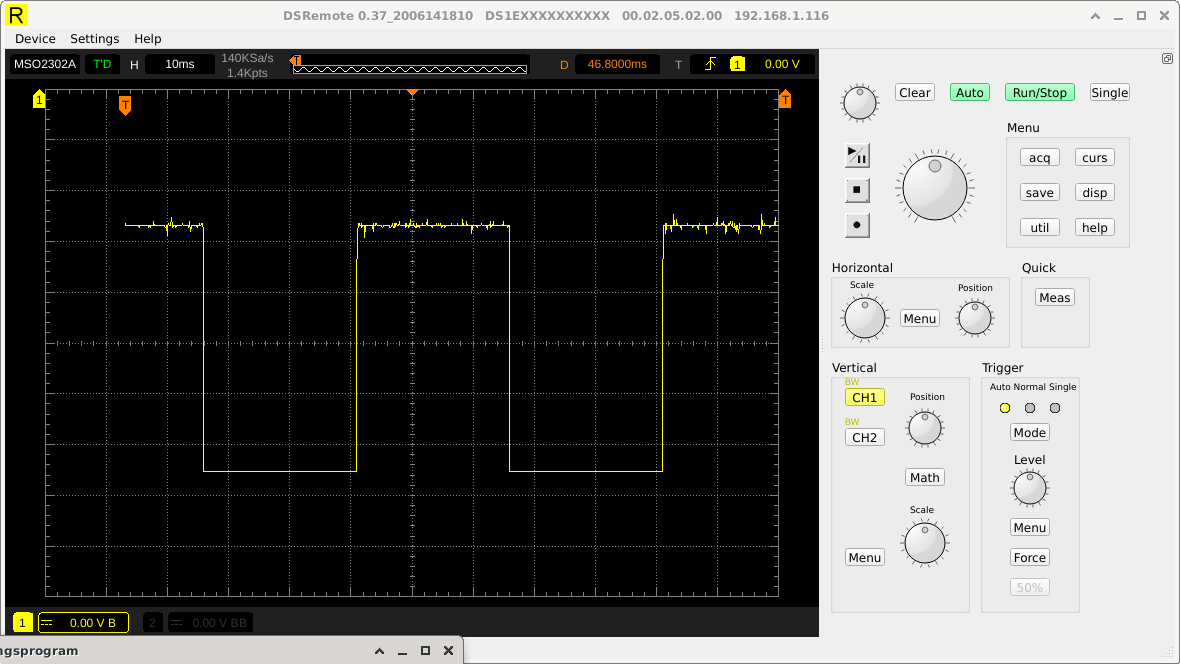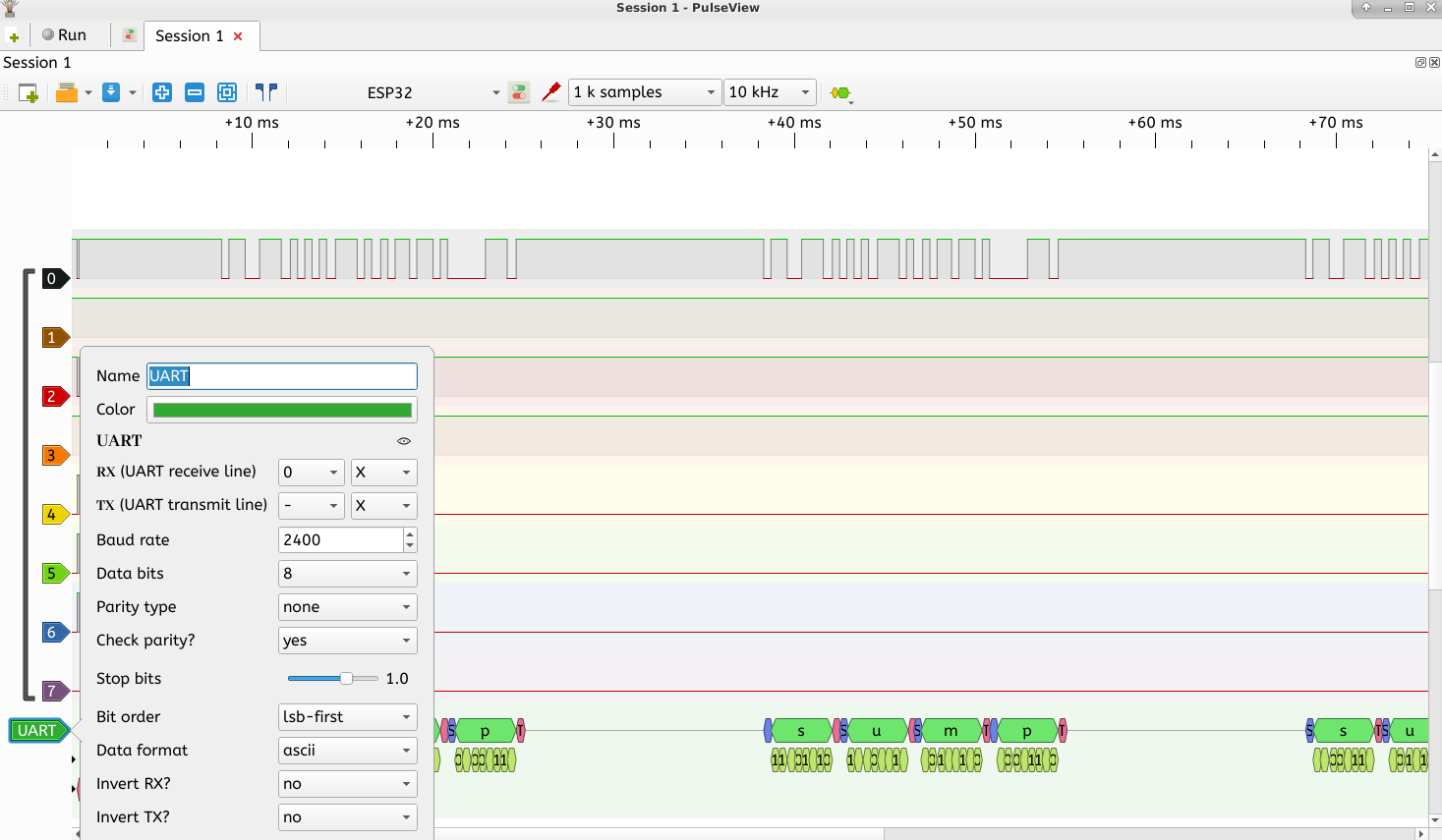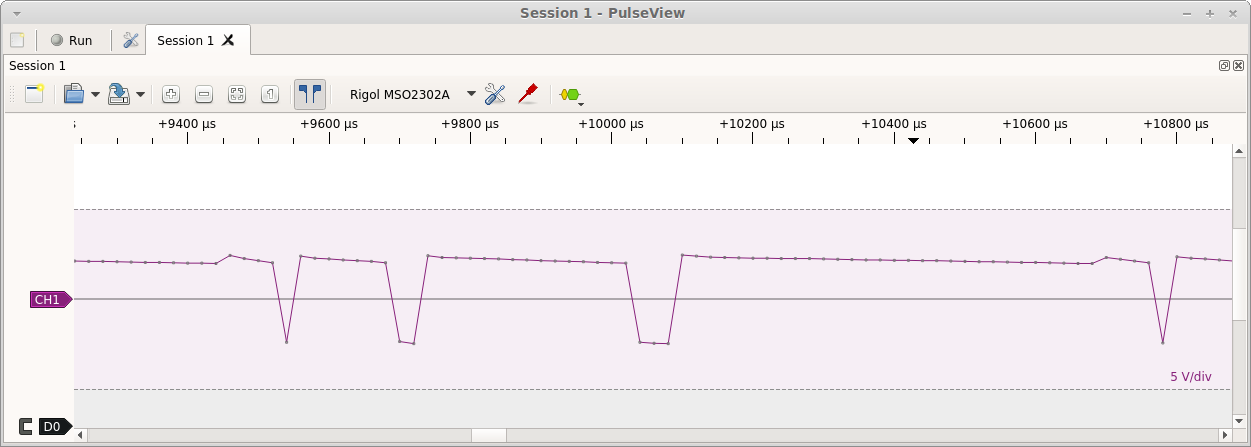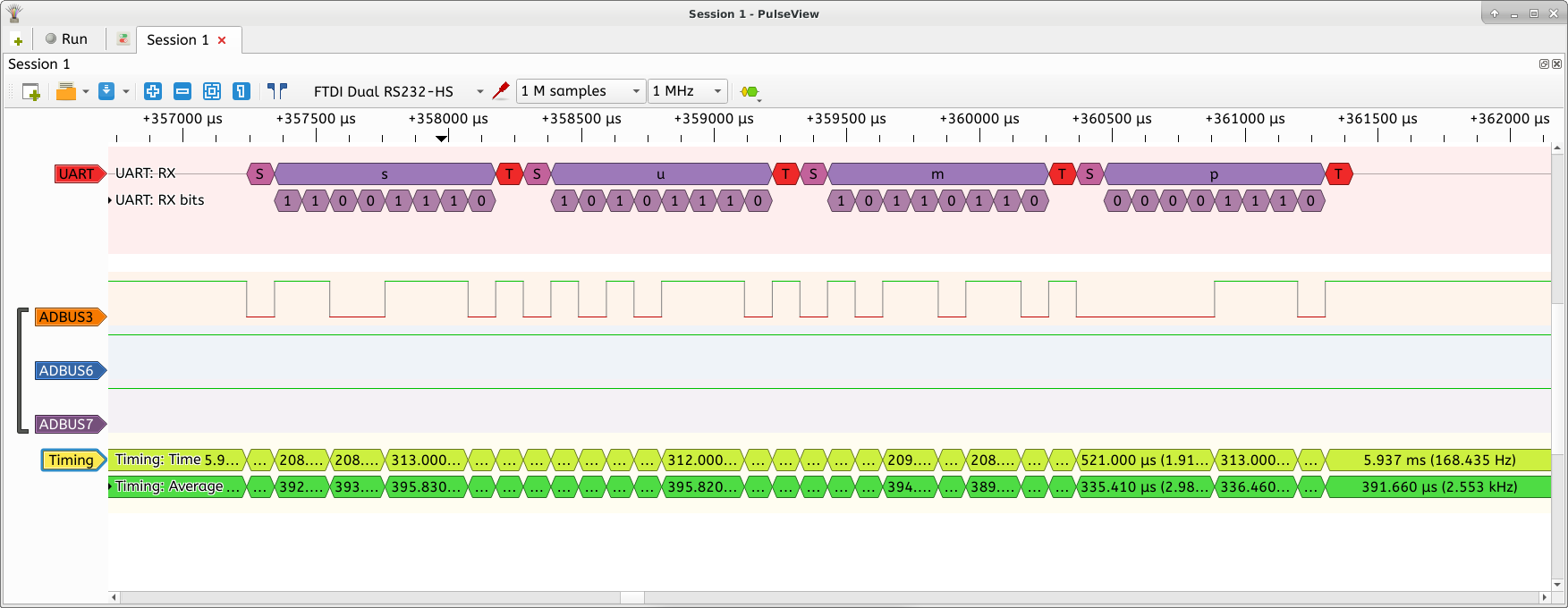A SUMP compatible logic analyser for the esp32, for use with i.e sigrok https://en.wikipedia.org/wiki/Sigrok
For digital input, an Open bench logic sniffer is emulated. (ols) A Rigol DS scope (rigol-ds) is emulated in order to allow sampling of analouge input. Use pulseview to get the graphical input.
The different options as described below are defined in the file app-config.h The default configuration is to use rigol-ds over ethernet port 5555 Go to the configuration options and set ssid and password make menuconfig Wifi and TFT Configuration --->
Also set
Bootloader log verbosity (No output) --->
Compiler options -> Optimization Level (Release (-Os))
→ Component config → ESP32-specific -> CPU Frequency (160 Mhz)
If you change frequency, you have to set timings differently in
void setTimescale(float scale)
Currently timing is calculated by counting cycles.
Analuge data is temporary disabled.
The for the Rigol, only 1400 of sample buffer is available.
Pin 17 is default connected (with the gpio matrox) (9600 Baud UART output)
Then start pulseview
Replace 127.0.0.1 with your
pulseview -d rigol-ds:conn=tcp-raw/127.0.0.1/5555 -l 5
Do not use timebase less than 1 ms as timing will not be accurate.
Pin 13-20 should be setup as input
Pin 17 is setup with uart test pulse
Pin 15 uses the remote device to send a test pulse
Only datasource live on the rigol emulation works.
PIN 36 is used for CH1, on esp32s2 PIN 1
Sampling is not properly calibrated, and code needs some care.
If you want to use only the analog input, you can use this program. https://github.com/Ebiroll/DSRemote
For the testsignal in the image, I used this 20Hz, square wave. http://www.keuwl.com/FunctionGenerator/
In branch esp32s2 you have esp32s2 support. Currenly it only runs with Extra SPIRam Analog input is on PIN1
Note, the only way to make this usable, would to use DMA with a steady campling rate. I try to use this in sampler.c, but was not successful If you would like to try, do change to #if 1 in sampler.c and #if 0 in analog.c
The pixel clock is defined in app-config .h
PIXEL_LEDC_PIN 22
Here I use Pin 27 for debugging (ledPin)
You have to change configuration in app-config.h to get this to work #define SUMP_OVER_UART 1 You will also have to go through the code.
You might have to press scan a few times until the ESP32 appears. Set samplingrate to 10 KHZ
When using the WROVER board do, sigrok-cli -d ols:conn=/dev/ttyUSB1 -l 5 --scan Otherwise when scanning sump sigrok-cli -d ols:conn=/dev/ttyUSB0 -l 5 --scan
Just set correct display in config. The green line has a quarter of the sampling speed comapre to the white line
Make sure we got
#define CONFIG_EXAMPLE_USE_TFT 1
You can also define
#define USE_SEMA 1
Then sampling will be done in a separate thread.
This gives much wose results!
It is also possible to change the constant in analog,c
Lower value -> Higher sampling rate.
// A complete sample loop takes about 8000 cycles, will not go faster
#define COUNT_FOR_SAMPLE 17000
However, It does not work with all 3 variants enabled at the same time.
(ADC1_CHANNEL_0) //GPIO 36
Still lots of tuning to do here.
Pins that can be used for logical input on the WROVER board.
12,
13,
14,
15,
Pins defined for logical input with the code in this repository over SUMP.
12,
13,
14,
15,
Pins defined for logical input with the code in this repository rigol-ds.
13,
14, // Remote device
15,
16,
17,
18,
19, // UART RX
20, // Missing???
21,
22,
23,
24,
25,
26,
27,
28,
29
Testdata in this example. To get testdata connect i.e pin 17 & 22 and pin 23 & 18
17, remote device, square pulse
18, 9600 Baud UART with repeated text, "sump UUU"
If using the WROVER-kit, you can use the JTAG chip to do data aquisition. To get better debuginfo, start pulseview with logging, -l 5 On the WROVER dev kit, it seems that the FTDI-LA drivers are used.
https://sigrok.org/gitweb/?p=libsigrok.git;a=tree;f=src/hardware/ftdi-la This allows sampling without a second ESP32 up to 10Mhz.
In the code the sump protocol is implemented over serial and tcp/ip.
I found that the terminal program cutecom allowed sending single HEX bytes, this is useful for debugging the implementation of the SUMP protocol.
In sigrok the following WROVER-KIT pins are mapped like this.
PIN13 = ADBUS0
PIN12 = ADBUS1
PIN15 = ADBUS2
PIN14 = ADBUS3
THE Jtag interface uses the following pins.
1 CHIP_PU TRST_N
2 MTDO / GPIO15 TDO
3 MTDI / GPIO12 TDI
4 MTCK / GPIO13 TCK
5 MTMS / GPIO14 TMS
The following red/green/blue led is available on the WROVER kit.
RED gpio_set_direction(GPIO_NUM_0, GPIO_MODE_OUTPUT);
GREEN gpio_set_direction(GPIO_NUM_2, GPIO_MODE_OUTPUT);
BLUE gpio_set_direction(GPIO_NUM_4, GPIO_MODE_OUTPUT);
gpio_set_level(GPIO_NUM_0, 0);
After making sure you use the correct Component config → ESP32-specific -> Main XTAL frequency Another good idea, might be to set these values.
Bootloader log verbosity (No output) --->
Compiler options -> Optimization Level (Release (-Os))
Otherwise they will interfere with the SUMP protocol.
To get some test data, connect a 500/250 microS pulse is generated with the remote device on pin 14 (D2)
app_main() {
...
send_remote_pulses();
rmt_write_items(config.channel, items, 1, 0);
}
When starting the sigrok gui, pulseview, the device was identified and this is how the timing analysis looks like.
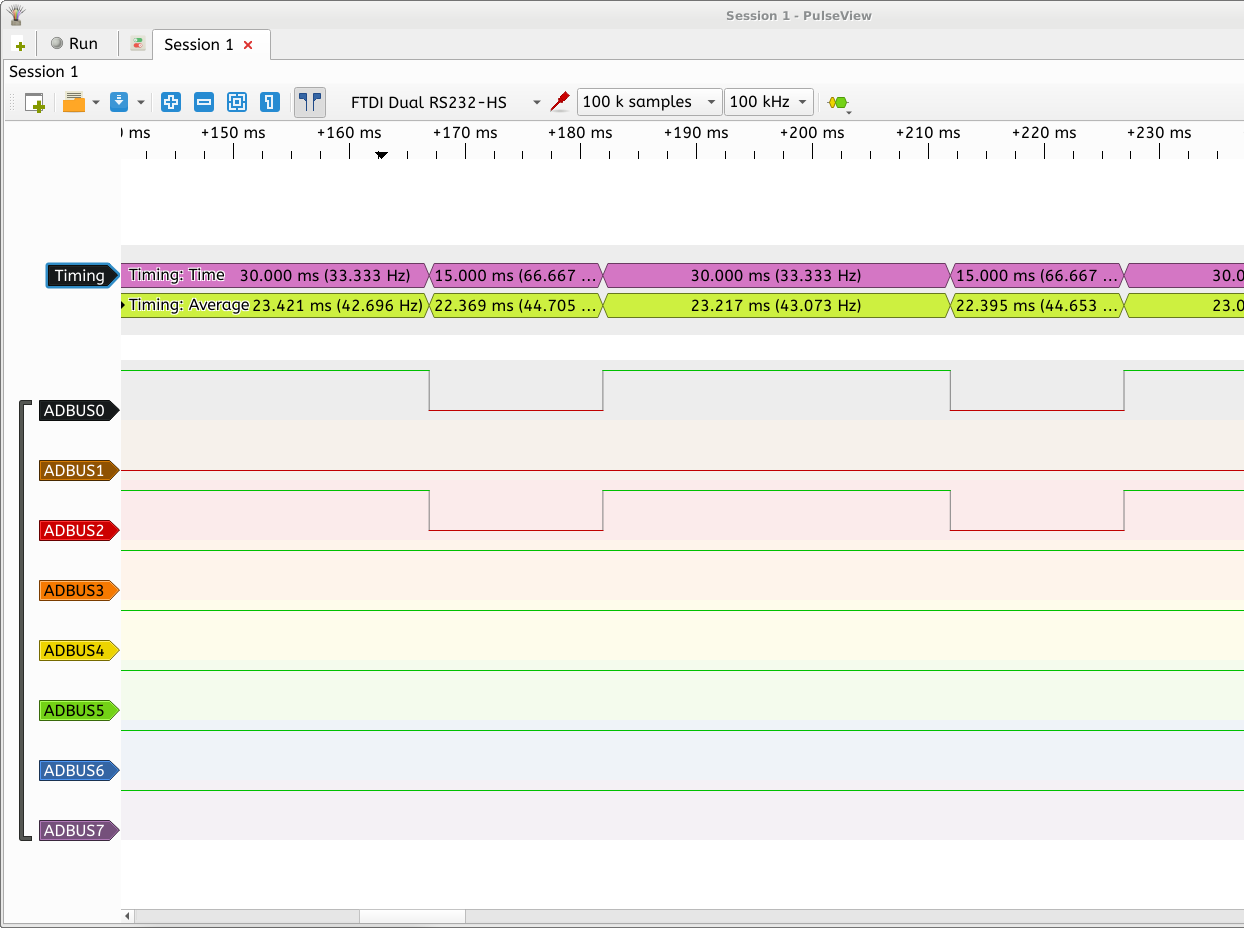 [https://raw.githubusercontent.com/Ebiroll/esp32_sigrok/master/sigrok.png ]
[https://raw.githubusercontent.com/Ebiroll/esp32_sigrok/master/sigrok.png ]
To get some more testdata the uart sends the text "sump" on pin 18
static void uartWRITETask(void *inpar) {
uart_port_t uart_num = UART_NUM_1;
echoLine[0]='s';
echoLine[1]='u';
echoLine[2]='m';
echoLine[3]='p';
while(true) {
int size = uart_write_bytes(uart_num, (const char *)echoLine, 4);
vTaskDelay(10 / portTICK_PERIOD_MS);
}
}
Analog values are compressed so the actual values are not correct.
The remote device has stopped working, not sure if this is an esp-idf issue or some accidental change in my code.
I removed it from the default setting.
However, now it is working with sigrok and the latest version of esp-idf.
Perhaps this bugfix was helpful, but initially the SUMP protocol was not working https://github.com/espressif/esp-idf/commit/f482e9e54ce83e249e46f5ee082f6ffb61431339
If you test repeatedly with
sigrok-cli -d ols:conn=/dev/ttyUSB1 -l 5 --scan
sigrok-cli -d rigol-ds:conn=tcp-raw/192.168.1.130/5555 -l 5 --scan
With my version of sigrok and esp-idf rigol-ds now works 10/10 times
The sump part of the code has not received much attention lately, but probably works.
You should use the app-config.h file to set the behaviour you want.
//init_uart();
scpi_server_init(&xHandlingTask);
//sump_init();
//sump_server_init();
//sump_uart();
For digital data with ols (sump) driver
init_uart();
//scpi_server_init(&xHandlingTask);
sump_init();
//sump_server_init();
sump_uart();
sump_server_init(); is used for SUMP data on port 5566 and debugging Normal rigol-data is handled on port 5555
Further development of ESP32 as a scope will be carried out in the dev branch,
In pulseview
Chose driver, Open bench Logic sniffer (ols)
Choose the interface, i.e./dev/ttyUSB0
Press Scan for devices,
If successful select ESP32 with 8 channels.
Change samplerate 10kHz. Its currently hardcoded to sample at this rate.
I did some experimental aquisition with parallell i2s aquisition in espScope.c The idea was to to route out the audio PLL signal and use as PCLK input Also the HSYNC and VSYNC siglnals must be HIGH for DMA sampling to work However, I never got this to work. Probably some other clock signal is missing.
Also you can add more input pins by adding them in, uint16_t getSample() & portc_init(void)
For analog data try the rigol-ds over wifi on port 5555.
SCPI on network, works well in QEMU, but over wifi with esp-idf lwip netconn is broken. The old file scpi_server.c is kept but the new file is called scpi_socl_server.c Add #define RUN_IN_QEMU 1 in app-config.h
xtensa-softmmu/qemu-system-xtensa -d guest_errors,unimp -cpu esp32 -M esp32 -m 4M -net nic,model=vlan0 -net user,id=simnet,ipver4=on,net=192.168.4.0/24,host=192.168.4.40,hostfwd=tcp::5555-192.168.4.3:5555 -net dump,file=/tmp/vm0.pcap -s > io.txt
And client can be run as,
./olas-cli -d rigol-ds:conn=tcp-raw/127.0.0.1/5555 -l 5 --show
pulseview -d rigol-ds:conn=tcp-raw/127.0.0.1/5555 -l 5
If you enable Partition Table (Factory app, two OTA definitions)
You can update the application with (change according to your IP)
curl 192.168.1.111:8032 --data-binary @- < build/sigrok.bin
When developing, These commands are useful and repeatable
sigrok-cli -d ols:conn=/dev/ttyUSB0 -l 5 -c samplerate=10Khz --samples 100
sigrok-cli -d ols:conn=/dev/ttyUSB0 -l 5 --scan
sigrok-cli -d ols:conn=/dev/ttyUSB1 -l 5 --show
SCPI over the network also works now.
sigrok-cli -d rigol-ds:conn=tcp-raw/127.0.0.1/5555 -l 5 --scan
It is possible tp run sump over network or USB, however ols driver only supports SUMP over serial. To use SUMP over network you must find some other program. I tried the PIPISTRELLO p-ols driver. This is however did not work.
To debug this use printf for debugging
void sump_debug(char *str,unsigned int value) {
printf("%s 0x%X\n",str,value);
}
Remove call to init_uart //init_uart(); screen /dev/ttyUSB1 115200 sigrok-cli -d p-ols:conn=tcp-raw/192.168.1.130/5566 -l 5 --scan
To debug SUMP over serial, then use TCP/IP for debugging.
To use debug output, remove #if 0 in:
sump_debug()
nc 192.168.1.130 5566 This port is also used for the SUMP protocol over TCP/IP If you use the Pipistrello OLS (p-ols) then you can use this sigrok-cli -d p-ols:conn=tcp-raw/192.168.1.130/5566 -l 5 --scan I never got SUMP over TCP/IP to work.
For data aquisition the high resolution timer is used. http://esp-idf.readthedocs.io/en/latest/api-reference/system/esp_timer.html
Trying to add rigol emulation and emulate sending of analouge and digital waveforms
In directory linux, you can build a test client, it also listens to port 5555 ./test
To try connect sigrok-cli -d rigol-ds:conn=tcp-raw/127.0.0.1/5555 -l 5 --scan This will send *IDN? to the instrument
You can also try this ./sigrock-cli -d rigol-ds:conn=tcp-raw/192.168.1.130/5555 -l 5 --show
https://assets.tequipment.net/assets/1/26/Documents/Rigol/vs5000_programming.pdf
To build a debuggable version of sigrok-cli use the CMakeLists.txt file
mkdir sigrok;cd sigrok;
git clone git clone git://sigrok.org/libsigrok.git
// Not this?? git://sigrok.org/libsigrokcxx.git
git clone git://sigrok.org/sigrok-cli
cp ../sigrok_build/CMakeLists.txt
cd libsigrok
./autogen.sh
./configure --without-libbluez
Patch sigrok-cli/show.c to i.e. printf("sigrok-cli %s\n\n", "0.X");
cd ..
mkdir build;cd build; cmake ..
./olas-cli -d rigol-ds:conn=tcp-raw/192.168.1.127/5555 -l 5 --show
./olas-cli -d ols:conn=/dev/ttyUSB0 -l 5 --scan
To test reading data with sump. ./sigrok-cli -d ols:conn=/dev/ttyUSB0 -l 5 -c samplerate=10Khz --samples 100
https://github.com/EUA/ESP32_LogicAnalyzer
https://github.com/hydrabus/hydrafw/wiki/HydraFW-SUMP-guide
https://github.com/jpbarraca/LogicAlNucleo/blob/master/src/main.cpp
https://github.com/tuxyme/metal-pi/blob/master/analyzer/main.c
https://github.com/gillham/logic_analyzer/blob/master/logic_analyzer.ino
QT rigol scope https://gitlab.com/Teuniz/DSRemote
https://github.com/hackrid/pyrigolla/
Other than the SUMP protocol we could try to emulate this RIGOL osciloscope, https://www.batronix.com/shop/oscilloscopes/Rigol-VS5202D.html
https://assets.tequipment.net/assets/1/26/Documents/Rigol/vs5000_programming.pdf
Data format,
https://en.wikipedia.org/wiki/Standard_Commands_for_Programmable_Instruments
https://github.com/cjameshuff/rigolutils
http://literature.cdn.keysight.com/litweb/pdf/81180-91020.pdf
https://grenville.wordpress.com/2015/01/04/a-clone-of-the-saleae-logic-8-channel-analyser/
